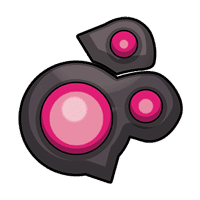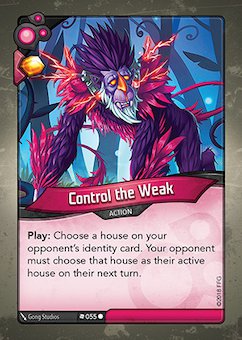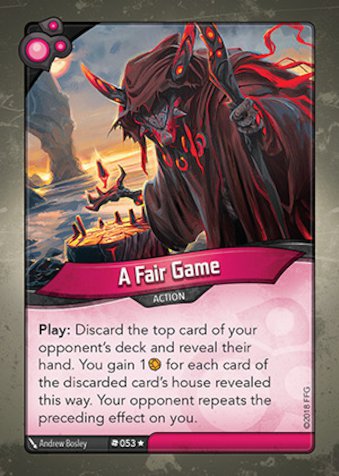Now that Keyforge is a few months old and picking up steam every day, it’s time to dive a little bit into the lore and setting of Keyforge, starting with the seven Houses. Thus Open House series, where we will dive into both the lore of one of the Houses as well as outlining some key cards, mechanics and strategies that makes that House unique. It’s time to meet the neighbours!
Our first House were our beloved saviours. Holy knights of pure light encased in armour. They consist of every white knight trope you can think of! Meet Sanctum.
From the holy gardens of House Sanctum let us descend now into the demonic depths for our second Open House. Here I shall I introduce you to the menargie of cruelty that is House Dis.
 Keyforge: Overview of House Dis
Keyforge: Overview of House Dis
As you might come to expect to a demonic horde, the House of Dis have a far looser structure than a lot of the other houses, though not many have had the chance to observe them and live. The House consists mostly of demons, who are drawn to extremes of emotion that they use for nourishment, and imps who serve the whims of the demons, who usually act scout and steal Æmber.
There are some humans who voluntarily join the House, as well, though the rulebook says “the less said about them, the better.”
Of course, as you might expect, demons are not pleasant individuals, and the demons of Dis are no exception. Living, in the underground of the Crucible, the demons and imps of House Dis seek to steal Æmber and kill any who resist them, often in cruel and tortuous ways. While many demons in the lore of other games typically have little rhyme or reason to their actions, the demons of House Dis have more of a purpose to their cruelty. They are drawn to extreme emotions, and use them as a source for their sustenance.
While many in the Crucible believe demons steal your soul, the minds of House Logos take a more scientific approach, and believe that the demons are a form of parasitic lifeform that use the psycho-reactive properties of Æmber in order to capture emotional and mental imprints, which they use for their nourishment. Surely, the demons prefer the soul-stealing theory as it’s the more terrifying explanation.
Unsurprisingly, like the rest of the Houses on Crucible, the acquisition of Æmber lies at the heart of their motivations. In order to equip themselves, House Dis embed Æmber in every part of their technology in order to be able to capture more emotions. Using the furnaces deep within their underground lairs, they smelt black iron and Æmber into create shards that they use to power machines and their imps who are then sent out to acquire more. It’s also where they break down the “souls” for food for the demons. Being demons, they also prefer to have unnecessarily sharp edges to everything and spikes to everything. Can you really blame them, though? Everyone has a Goth phase.
The Archons appear to be the only beings that can truly commuicate with House Dis. Some welcome the demons into their forces, possessing a morbid fascination with their emotional extremes. Others, clearly lacking moral centres, are drawn to their sadism, and their brutally effective ways. For the demons’ part, one can imagine that the Archons are the only beings that they might see worthy of following. It is true that there is no shortage of carnage in the aftermath of chasing down Vaults.
 Keyforge: Using Dis in your decks
Keyforge: Using Dis in your decks
Although they are characterized as bloodthirsty demons, House Dis plays less aggressively than you might think. Instead they could be better characterized as the “control” faction, with the House’s key strengths being how they can limit your opponent, how they can manipulate them, or short of that how they can simply destroy whatever is in their way.
Of the three strengths, limiting your opponent is probably the most annoying. For them that is. Dis possesses the ability to reduce the cards your opponent can draw with Succubus, can limit how many cards they can play with Ember Imp, or chew up the opponent’s hand with Tocsin or Mind Barb. You can also limit what’s on the battleline by sending creatures back to the hand with the likes of Fear and Hysteria (the demons sure think they’re scary, eh?). No matter what load out you get with Dis in your deck, you’ll likely be able hamstring your opponent in one of these ways.
Dis also has the ability to manipulate the opponent. While similar to limiting, there is a subtle difference in that with manipulating, you get to literally control what the opponent can do. This comes in the form of Control the Weak and Restringuntus, the former allowing you to force the opponent to pick a certain house during their next turn and the latter allowing you to completely prevent the opponent from picking a particular house for as long as Restringuntus is in play. This allows you to heavily influence how the game gets played, and done in the right way at the right time can easily win you the game.
Finally, fittingly for demons that feed off of carnage, Dis has the ability to destroy creatures in spades. While Logos and Sanctum can also be good at clearing the battlelines, they’re often done in broad sweeping motions clearing mostly everything indiscriminately.
While Dis has that, it also has the ability to target very specific creatures for surgical removal. While you have Key to Dis that targets everyone you also have Master of One, Two and Three, who can target creatures of those power levels and kill them. Three Fates can take out your opponent’s powerhouses, while Hand of Dis is more flexible allowing you to take out anything that isn’t on a flank. When it comes to outright destruction, Dis does have some of the best versatility in the game.
 Keyforge: Key Dis Cards
Keyforge: Key Dis Cards
Now I want to delve into a few of my favourite cards and explore some strategies with them. First card I want to look at is Bulwark.
Now let’s tackle some specific cards and their deliciously evil ways. Let’s first take a look at one I had mentioned earlier, Control the Weak.

Control the Weak is your bread and butter control card that let’s you manipulate the opponent. The ability to force your opponent to choose a certain house is obviously very appealing, but there’s far more damage you can do with this card if you pay close enough attention. First, when making the call, obviously pay attention to the battleline. If your opponent has a lot of creatures of a particular House, you’ll want to force your opponent to be unable to use those creatures. This is a good play if you have some vulnerable creatures you want to throw down and want to protect them from retribution on the battleline.
A more advanced play is to pay careful attention to what cards the opponent has played. If you count properly, you can make assumptions of what they have in their hand, and if you call right, you might be able to pick a House that leaves the opponent with no cards they can play from their hand. I’ve had the misfortune of being in that position and it’s an absolutely bonkers play, that leaves you a turn ahead. Remember when counting that every deck has twelve of each of House’s cards.
The next card I want to tackle is good ol’ Tolas.
Tolas is a dangerous beast. It gives you Æmber any time your opponent’s creatures die, but also gives your opponent Æmber any time your creatures die. Paired up with Dis’s inherent ability to kill, kill, kill; Tolas can be an Æmber factory, but if your opponent plays an aggressive deck with any Untamed, Brobnar or even Dis themselves, you risk netting them even more Æmber, so do pay careful attention to what deck you’re playing up against.
Finally, I want to take a look at one of the more complicated cards from Dis, but also one of its most fun: A Fair Game.

A Fair Game is a pretty janky card. You discard a card from the top of the opponent’s and then get an Æmber from every card that shares the same House that is in their hand. The opponent gets to do the same with you, however. It’s only fair, right? I’ve seen this card played a lot, and it has a pretty wide-range of outcomes. Sometimes you win big, sometimes you get barely anything, or the opponent wins big.
With some thought, however, you can tip the odds in your favour. This is a card that you’ll want to play last, after you’ve played most of your cards available to you. Having a smaller hand ensures your opponent will net less Æmber. Secondly, if you have cards that return creatures to their owner’s hand (like Fear or Hysteria), you’ll want to bust them out, since that’ll give you a better chance at a bigger pay day.
However, what I most love about this card is this short story featuring the demon in the card. It proves that not all demons have to be violent, some can be deceptively insidious.
 Keyforge House of Dis: Final Thoughts
Keyforge House of Dis: Final Thoughts
Overall, Dis is a good time. With the small sampling of players I’ve encountered, Dis comes out as a crowd favourite, and I can see why. You get to muster more control over the game with Dis than you do with a lot of other Houses.
Lore-wise, I’ve always loved me some good ol’ demons, and I do like the idea of demons literally harvesting and eating people’s emotions. Also, their aesthetic is really interesting, going for a more abstract/arcane look for the demons as opposed to the more over-the-top badass gorefests that you’ll see other incarnation of demonic creatures. Though there isn’t much to set Dis apart from any other demonic horde in other games, they are still a great time, and you can’t go wrong with having them in your deck.
For our next Open House we shall go from the raving demonic hordes to the savage wilds as we visit House Untamed. Stay tuned, Keyforgers!

